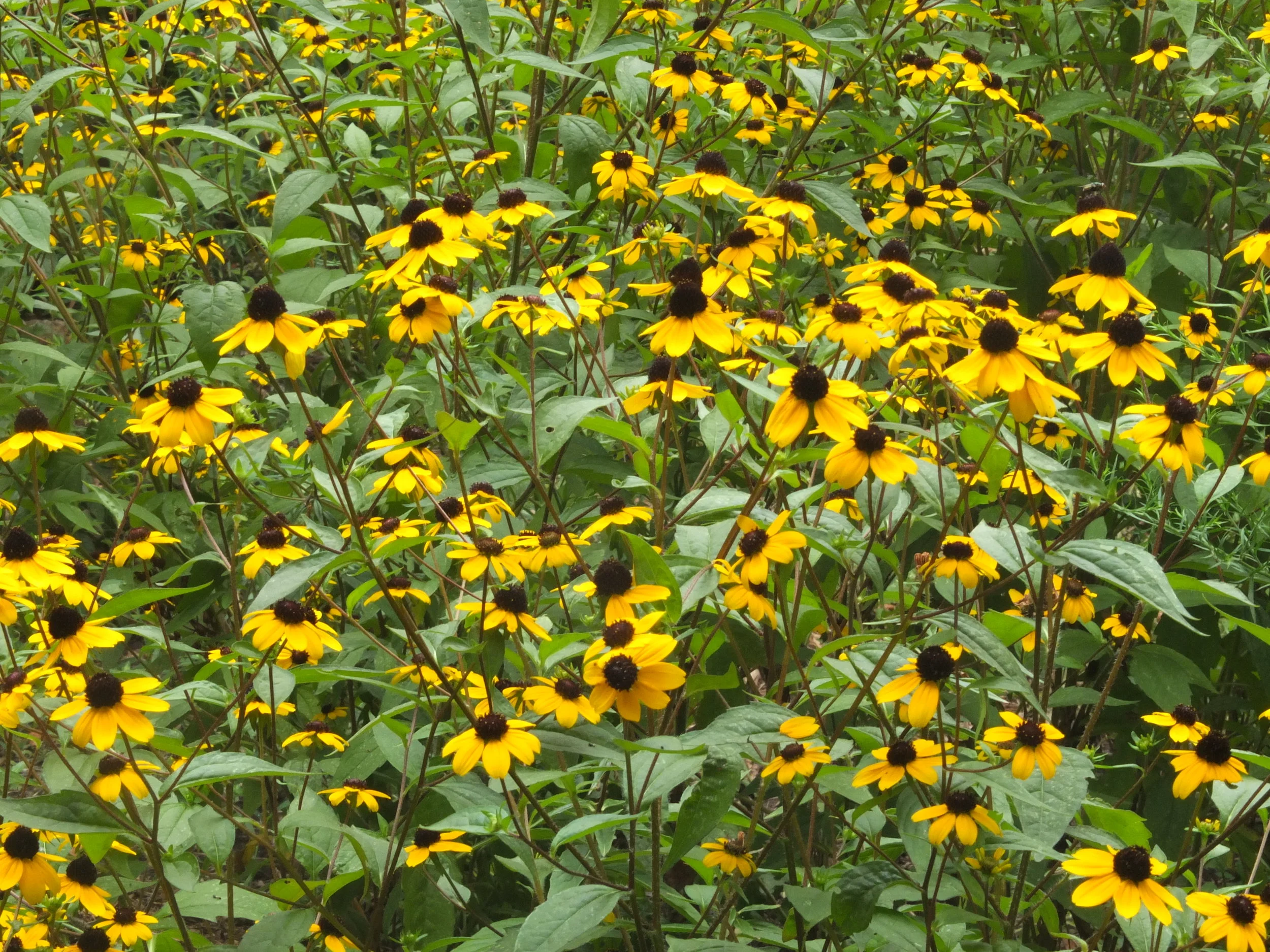Resources About Landscaping with Native Plants
On-line - Websites, Tools, Publications, Videos, Podcasts
Audubon Native Plant Database - Bring more birds to your home with native plants
https://www.audubon.org/native-plants/ -
Enter your 5-digit zip code to use Audubon’s native plants database and explore the best plants for birds in your area, as well as local resources and links to more information. (Audubon's native plants database draws its plant data from the North American Plant Atlas of the Biota of North America Program (BONAP).
https://ny.audubon.org/conservation/monthly-tips-reminders-healthy-yard
Audubon Plants for Birds Campaign Website
www.audubon.org/plantsforbirds
Backyard Habitat, National Wildlife Federation
www.nwf.org/In-Your-Backyard.aspx
https://www.nwf.org/NativePlantFinder/
This website offers zip code specific lists of native plants ranked by the number of butterflies and moths that use them as caterpillar host plants, based on the scientific research of Dr. Douglas Tallamy.
Better Backyard–A Citizen’s Resource Guide to Beneficial Landscaping and Habitat Restoration in the Chesapeake Bay Watershed
Chesapeake Bay Program - Publication, 61pages, downloadable
www.chesapeakebay.net/content/publications/cbp_12259.pdf
Chesapeake Bay Landscape Professional Certification Program
Hire a landscape pro trained in conservation landscaping with locally native plants.
https://cblpro.org/
Conservation Landscaping Guidelines - The Eight Essential Elements
Chesapeake Conservation Landscaping Council - Publication, 33 pages, downloadable
www.chesapeakelandscape.org
Growing a Greener World (TV Program):
Episode 012-Beneficial Garden Insects – Bringing Nature Home with Doug Tallamy (Aug 10, 2017)
Episode 023-Attracting and Protecting Pollinators with Eric Mader, Xerces Society (Oct 26, 2017)
Episode 071-Gardening for Wildlife: How-to Create an Inviting Habitat, with NWF’s David Mizijewski (Sep 27, 2018)
Episode 077-The Beauty and Importance of Native Plants: The Ethos of Mt. Cuba Center (Nov 8, 2018)
Episode 620 – Bringing Nature Home (Nov 25, 2015)
Episode 1008 - Bringing Nature Home (Oct 26, 2019)
Interviews with Doug Tallamy, author of Bringing Nature Home and Nature’s Best Hope, and with Rick Darke, author of The Living Landscape
Habitat at Home (basic overview)
Virginia Department of Wildlife Resources - Publication, 8 pages, downloadable
https://www.dgif.virginia.gov/wp-content/uploads/habitat-at-home.pdf
Habitat Gardening for Wildlife
Virginia Department of Wildlife Resources - Publication, 34 pages, downloadable
https://www.dgif.virginia.gov/wp-content/uploads/habitat-gardening.pdf
Let’s Grow Native Articles - Virginia Wildlife Magazine:
Native Habitat (Mar - Apr, 2019)
Pollinators (May - Jun 2019)
Shrubs in Fall (Sep - Oct 2019)
Leaves and Mulch (Nov - Dec 2019)
Shrubs and Berries (Jan - Feb 2020)
Water Features (Mar - Apr 2020)
Spring Favorites (May - Jun 2020)
Monarchs (Sept - Oct 2020)
Groundcovers (Nov - Dec 2020)
Hometown Habitat (film)
by Catherine Zimmerman in partership with Chesapeake Bay Landscaping Council
http://themeadowproject.com/hometown-habitat/
Living Shoreline Design (Shoreline Native Plant List)
http://ccrm.vims.edu/livingshorelines/index.html (go to “Plants and Vendors”)
Maryland Native Plant Society Landscaping with Native Plants
https://mdflora.org/resources/Publications/GardenersGuidelines/Landscaping-Natives.pdf
Native Plant Podcast
www.nativeplantpodcast.com/#home-section
Pollinator Partnership Website
www.pollinator.org/
Pollinators, U.S. Fish & Wildlife Service Website
https://www.fws.gov/initiative/pollinators
U.S.D.A. Forest Service: Pollinators Website
www.fs.fed.us/wildflowers/pollinators
Virginia Home Grown (TV Program)
https://www.pbs.org/show/virginia-home-grown/
Wild Ones Handbook Online - Landscaping with Native Plants
U. S. Environmental Protection Agency
www.epa.gov/greenacres/wildones
Xerces Society:
Website - https://www.xerces.org/pollinator-conservation
Magazine - WINGS: Essays on Invertebrate Conservation - www.xerces.org/wings-magazine/
Yard Design Tool
Alliance for the Chesapeake Bay Reduce Your Stormwater Campaign
www.stormwater.allianceforthebay.org/yard-design
Schoolyard Habitat
Poster produced as part of a Love-A-Tree kit by a partnership, including International Paper, Virginia Dept of Environmental Quality, Virginia Dept of Game and Inland Fisheries (now Dept of Wildlife Resources), Virginia Coastal Zone Management Program, and Virginia Dept of Conservation and Recreation. (Nov 2011)
Side two of poster includes a list of state-wide suitable native plants for use in schoolyard habitat projects, a lesson plan and resources for Schoolyard learning.
In Print
Armitage’s Native Plants for North American Gardens, 2006, Allan M. Armitage
Attracting Birds, Butterflies & Other Winged Wonders to Your Backyard, Kris Wetherbee, 2004
Attracting Butterflies & Hummingbirds to Your Backyard, Sally Roth, 2001
Bee Basics: An introduction to Our Native Bees, Beatriz Moissett and Stephen Buchmann, A USDA Forest Service and Pollinator Partnership Publication, 2011
Birdscaping Your Garden: A Practical Guide to Backyard Birds and the Plants That Attract Them, 1994, George Adams
Bringing Nature Home: How You Can Sustain Wildlife with Native Plants, Douglas W. Tallamy, 2009 (updated and expanded)
Nature’s Best Hope, Douglas W. Tallamy, 2020
The Nature of Oaks: The Rich Ecology of Our Most Essential Native Trees, Douglas W. Tallamy, 2021
http://bringingnaturehome.net
Chesapeake Gardening & Landscaping: The Essential Green Guide, Barbara W. Ellis, University of North Carolina Press, 2015
Essential Native Trees and Shrubs for the Eastern United States: The Guide to Creating a Sustainable Landscape, Tony Dove and Ginger Woolridge, 2018
Kaufman Focus Guides, Butterflies of North America, Jim P. Brock and Kenn Kaufman, 2003
Insects and Gardens: In Pursuit of a Garden Ecology, Eric Grissell, 2001
National Wildlife Federation: Attracting Birds, Butterflies & Other Backyard Wildlife, 2004, David Mizejewski
Planting in a Post-Wild World: Designing Plant Communities for Resilient Landscapes, Thomas Rainer & Claudia West
Pollinator Conservation Handbook, The Xerces Society, 2003
Pollinators of Native Plants, Heather Holm, Pollination Press LLC, 2014
The Forgotten Pollinators, Stephen L. Buchmann and Gary Paul Nabhan, 1997
The Humane Gardener: Nurturing a Backyard Habitat for Wildlife, Nancy Lawson, 2017
The Xerces Society Guide to Attracting Native Pollinators, Eric Mader, et al., 2011
The Life Cycles of Butterflies: From Egg to Maturity, a Visual Guide of 23 Common Garden Butterflies, 2007, Judy Burris
The Living Landscape: Designing for Beauty and Biodiversity in the Home Garden, Rick Darke and Doug Tallamy, 2014
This book addresses the things we can do at home to create a more hospitable habitat for native plants and creatures. Stunning photography by Rick helps illustrate each point. One of Rick’s key concepts to creating a living landscape is by focusing on building layers into the landscape.


